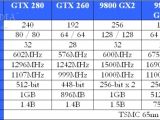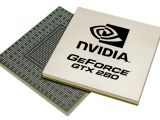This week, as most of you already know, the Santa Clara-based chip manufacturer, NVIDIA, has decided to get official with its latest graphics card lineup. What followed was a series of benchmarks and reviews that shared some light on the performance level of NVIDIA's GT200-series. But because these cards have been extremely anticipated, everybody had high hopes regarding their performance level. And fortunately for NVIDIA most of the ongoing benchmarks and reviews revealed that both the GTX 260 and GTX 280 provide an improvement in graphics performance, as compared to anything else that is now available on the market.
The innovation
Before you start reading, be sure to check out this specification list of NVIDIA?s top GeForce graphics cards, so you can better understand how they have evolved. The performance level of these cards is undoubtedly high, but then again this was to be expected from the current leading manufacturer of computer graphics. What is really interesting is that unlike NVIDIA?s previous GeForce series, these new GT200-based cards have came out with two new technologies that are meant to boost their overall performance. I?m talking here about PhysX and Cuda.
A PhysX ready product has been expected from NVIDIA since the green company acquired Ageia. But users who want to benefit from NVIDIA?s physics technology will require one of its PhysX-ready cards and its PhysX drivers, which it hasn?t made available yet. The PhysX factor in NVIDIA?s latest GPUs is meant to deal with a number of hardware demanding physical gaming environments that can enhance a user?s overall gaming experience.
But if the PhysX technology has been designed to enhance visual experience for gamers, when it comes to CUDA, we?re talking about a totally different thing here. CUDA is meant to improve the overall performance of a computer system by unlocking the GPU processing power to accelerate the most demanding system tasks. This is why the technology has been touted to bring an end to the CPU, as a single CUDA-enabled GPU could perform better on both general computing and graphics performance. Still, nobody rushes to claim that NVIDIA?s new GT200-series will be everything a computer user will need (leaving out the need for a standard CPU), but it will sure bring better graphics (than previously available) for desktop computers.
Also take into account that NVIDIA?s cards are not only your everyday gaming toy, they provide large amounts of power, which has been put into practice in more than one way. I am talking about FASTRA, the desktop supercomputer built by researchers at the University of Antwerp, which used four GeForce 9800 GX2 cards, for medical applications. This project should help you form an idea about what NVIDIA?s GeForce cards are really capable of.
The truth
The question is: Who really needs a $650 graphics card? I tend to think it won?t be gaming users, as they will probably find their necessary graphics power by searching for more affordable alternatives. And I also tend to believe that NVIDIA thinks that gamers will search for lower priced cards, which is why they will bring two new cards to the market, but as part of their GeForce 9000 series.
By now, most people believe that AMD?s ?yet-to-get the official treatment? HD 4870 will no be able to provide the same graphics power as NVIDIA?s current flagship model. But it will come pretty close at a better price tag, which will make it more appealing to gaming users who want to upgrade their gaming rigs. This is exactly where the GeForce 9800 GTX+ (plus) and GeForce 9800 GT come into play. These two cards are part of NVIDIA?s GeForce 9000 lineup, but will be different than any other card NVIDIA currently offers. The cards will be built using the same manufacturing process as on AMD?s HD 4000 series, the 55nm.
The 9800 GTX+, a 55nm overclocked version of NVIDIA?s 9800 GTX, is going to provide more power at a lower price tag (somewhere in the $220 area). If the card is released, NVIDIA will most probably also lower the price tag for its GeForce 8800 Ultra and 9800 GTX. This also means that those who have already acquired one of NVIDIA?s 9800 GTX cards would have spent more money on a card with a performance level below the "plus" edition.
With the 9800GT NVIDIA hopes to provide users with an affordable alternative to AMD?s Radeon HD 4850. This card is also going to benefit from a 55nm fabrication process but will come with lower performance than the 9800 GTX+ model.
At this point, no one can tell for sure when these two new G92-based cards are going to hit the store shelves, but speculations indicate August as a potential timeframe.
Conclusion
NVIDIA did a great job at marketing its new products, but then again this is one thing that the Santa-Clara chip manufacturer does best. And considering all the recent reviews that have put the cards in the spotlight, NVIDIA will most probably continue its reign over AMD as the leading manufacturer of high-end graphics cards. And with the new GeForce 9000 products, they will also have a more that smooth ride on the mainstream market, a place where AMD is at its best.
Next week AMD will have the scene, as the company is expected to finally release their new Radeon HD 4000 series cards.

 14 DAY TRIAL //
14 DAY TRIAL // 


